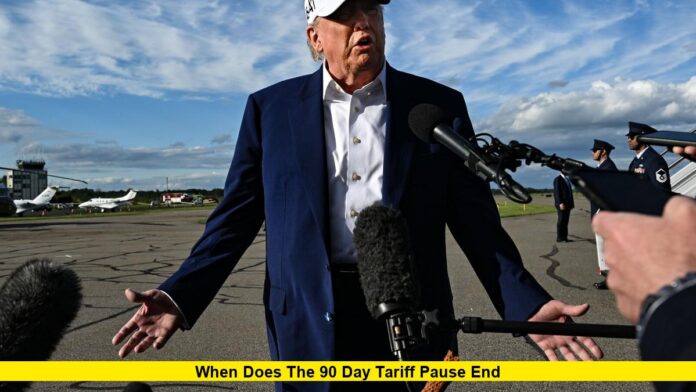The question on everyone’s mind—when does the 90 day tariff pause end?—has become the focal point for global markets, policymakers, and businesses as the deadline rapidly approaches. The Trump administration’s 90-day reprieve on sweeping U.S. tariffs, announced in early April as part of a high-stakes trade negotiation strategy, is set to expire on Wednesday, July 9, 2025. This looming deadline has triggered a flurry of diplomatic activity, economic speculation, and strategic recalibration among America’s trading partners.
Key Point Summary:
- 90-day tariff pause ends July 9, 2025, for most countries.
- China’s pause lasts until August 12, 2025.
- Tariffs could revert to rates as high as 50% for some nations.
- Some countries have negotiated extensions or new deals; others face economic uncertainty.
- Markets and businesses are bracing for potential volatility and inflation.
Global Markets on Edge as 90 Day Tariff Pause Ends
The end of the 90 day tariff pause marks a pivotal moment for global trade. President Trump’s administration has made it clear: countries that fail to secure new trade agreements with the United States by the July 9 deadline will face a return to the original, much steeper tariff rates announced on April 2, ranging from 11% to 50%. The move follows the so-called “Liberation Day” tariffs, which initially sent shockwaves through international markets and prompted the temporary pause to allow for negotiations.
With the deadline now imminent, the administration has begun sending out “letters” to trading partners—formal notifications of new tariff rates or finalized deals. While some countries, such as Canada and the UK, have managed to secure last-minute agreements or extensions, others remain in tense negotiations, hoping to avoid the economic fallout of higher tariffs.
Also read-No Tax on Overtime Explained: Trump’s Promise Gets Real, But There’s a Catch
What Happens After July 9? The End of the 90 Day Tariff Pause
The expiration of the 90 day tariff pause on July 9, 2025, is set to trigger a cascade of changes in U.S. trade policy. For countries that have not finalized agreements, tariffs will revert to the elevated levels set out in April. Notably, U.S. officials have confirmed that these new rates will officially take effect on August 1, giving some nations a brief window to wrap up negotiations or seek exemptions.
Canada, for example, managed to secure an extension until July 21 by agreeing to U.S. demands to repeal its controversial digital services tax. China, meanwhile, faces a separate deadline: its reduced tariff rate of 10% will remain in place until August 11, after which it will jump to 34% unless a new deal is reached.
The European Union is also in the crosshairs. President Trump has threatened to increase tariffs on EU goods to 50% if a deal is not reached by July 9. EU officials have signaled a willingness to make sector-specific concessions, particularly in automobiles, steel, and semiconductors, to avoid the steepest hikes. However, the prospect of retaliation remains, with the EU prepared to respond in kind if the U.S. follows through on its threats.
The Economic Impact of the 90 Day Tariff Pause Ending
The end of the 90 day tariff pause is expected to have significant economic repercussions. For businesses and consumers, the return of higher tariffs could mean increased costs, supply chain disruptions, and renewed inflationary pressures. Economists warn that the uncertainty surrounding the deadline has already begun to affect financial markets, with global equities experiencing volatility and the U.S. dollar coming under pressure.
Despite these concerns, some analysts believe that the Trump administration may still opt for last-minute compromises or targeted extensions, particularly for key allies or sectors where negotiations are close to completion. However, officials have downplayed the likelihood of a broad extension, emphasizing the administration’s commitment to using tariffs as leverage to secure better trade terms for American industries.
Table: Key Deadlines and Tariff Rates
| Country/Region | End of 90 Day Pause | New Tariff Rate (if no deal) | Extension Status |
|---|---|---|---|
| Most countries | July 9, 2025 | 11% – 50% | Possible extensions |
| China | August 12, 2025 | 34% | No formal extension |
| Canada | July 21, 2025 | 10% – 25% | Extension granted |
| EU | July 9, 2025 | Up to 50% | Negotiations ongoing |
What to Watch as the 90 Day Tariff Pause Ends
As the deadline approaches, all eyes are on Washington and the world’s major economic capitals. Key sectors likely to be impacted include automobiles, steel, aluminum, semiconductors, and pharmaceuticals. The U.S. has made it clear that zero-for-zero deals are off the table, and that tariff revenue is a strategic priority for funding domestic initiatives.
The possibility of further market volatility, retaliatory measures from affected countries, and a reshuffling of global supply chains remains high. Businesses are being urged to review their tariff strategies and prepare for a range of outcomes, including the potential for sudden changes in trade policy.
Conclusion
The end of the 90 day tariff pause on July 9, 2025, represents a critical juncture for global trade. With negotiations still underway and the threat of steep tariffs looming, the coming days will be decisive for the world economy. Whether the Trump administration opts for hardline enforcement or last-minute deals, the impact will be felt by businesses, consumers, and governments alike. Stay tuned for the latest real-time news and exclusive updates on the 90 day tariff pause and its aftermath. Share your thoughts in the comments—how will these changes affect your business or daily life?
